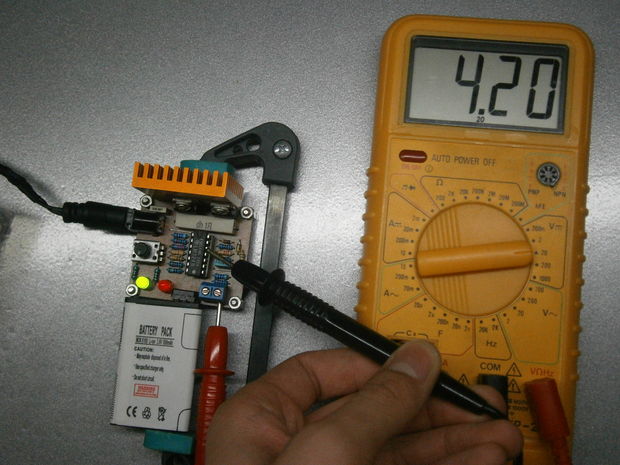Although [pinomelean’s] Lithium-ion battery guide sounds like the topic is a bit specific, you’ll find a number of rechargeable battery basics discussed at length. Don’t know what a C-rate is? Pfffft. Roll up those sleeves and let’s dive into some theory.
As if you needed a reminder, many lithium battery types are prone to outbursts if mishandled: a proper charging technique is essential. [pinomelean] provides a detailed breakdown of the typical stages involved in a charge cycle and offers some tips on the advantages to lower voltage thresholds before turning his attention to the practical side: designing your own charger circuit from scratch.
The circuit itself is based around a handful of LM324 op-amps, creating a current and voltage-limited power supply. Voltage limits to 4.2V, and current is adjustable: from 160mA to 1600mA. This charger may take a few hours to juice up your batteries, but it does so safely, and [pinomelean’s] step-by-step description of the device helps illustrate exactly how the process works.
[Thanks mansalvo]















Interestingly enough, that happens to be the same village my brain operates at
No batteries are burnin’, all is cool. If you had my steel guitar with lithium and all, you be jamin’ too. Yoo…ooo.
I recommend charging them up to 4.1V/cell since you’ll get more service life out of them.
This circuit lacks an auto-shutoff. Leaving Li-Ion batteries connected to 4.2V (called “float charging”) for extended periods can shorten their lifetime, which the Instructable fails to mention. At 4.2V, battery degradation is occurring at a fast pace. So most chargers only maintain the constant-voltage phase of charging for a few hours at most before shutting off; at which point the battery voltage drops on its own. Options:
1) Add some form of auto-shutoff to the circuit. Even putting an AC timer in front of the 12V power source will do. (But please verify that power can’t drain from the battery into the circuit while it’s powered down, I haven’t checked this.)
2) Always shut it off manually.
3) Choose a compromise voltage that deliberately undercharges the battery a bit, and in doing so, adequately reduces (but not eliminates) the damage from float charging. 4.1V seems to be a common recommendation for float charging Li-Ions, when necessary.
For *absolute* max lifetime from Li-Ion chemistry, keep charge as close to 50% at all times. It also helps to keep temperature low, even as low as freezing. Although in the real world such things aren’t really practical, except perhaps in planned long-term storage.
With all of the dedicated Li-Ion charging chips out there these days it is madness to build your own from discrete parts. If you want to build the circuit in order to study its behavior that is great, but if you just want a solution there are *much* better options.
While it is fun to design a charger, it is not a good idea if you don’t have safety features. It also need secondary safety shutdown like thermal protection, timeout. They are in the $1 single chip charger from the silicon vendors. e.g. TI, Microchip etc.
On the good charger chips, they would also change the charging rates depending on ambient temperature. i.e. no charging when temperature is too low and reduced charged rates at elevated temperature.
This is probably the next battery for the next decade. These battery lasts longer than others.
“prone to outburst”? That’s a bit dramatic.
They’re actually quite difficult to blow up unless you go to extremes.
Charging them at 2c or float charging them at 5v for days will not cause a fire.
For those looking for maximum life, 3.92v seems to be the concensus for typical LCO cells.
Cells with peak charging voltages of up to 4.35v are commercially available, and results for 4.5v batteries have been published in research papers.
While Li-po’s rarely blow, when they do go it tends to be a little dramatic. This makes it a lot more note worthy when one does go. I’ve seen the results when one blew. Specks of molten copper splattered around the room and some damage from a fire. While it was a rc battery, a little respect and safety checks are needed with them.
Was this intentional or accidental? What did it take to make it blow? i.e. how much voltage/current/heat?
I’ve seen dozens of Lipo batteries catch fire in the decade or so that I’ve been using them for RC hobbies. I’d say that “prone to outburst” is an understatement.
When handled and charged properly they’re fine. But when they do go bad, they really go bad.
For example:
https://www.youtube.com/watch?feature=player_detailpage&v=k9mcNvOGKtI#t=32
Here’s another – a pack that’s overcharged (but not by much):
https://www.youtube.com/watch?feature=player_detailpage&v=gz3hCqjk4yc#t=34
Search Youtube for “lipo fire” and you’ll find many more examples of “outburts.”
Still no specifics – voltage, current, etc. required to cause an ‘outburst’. Perhaps if ‘mishandled’ means physically damaged, I’ll agree. But anyone who says you’ll likely blow up a lipo by overcharging at 2C or to 5v is paranoid.
Meh you should check out the Thionyl Chloride lithium cells I have a work. Nothing like having a 1000 sticks of dynamite in the building to keep you honest.